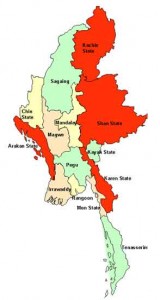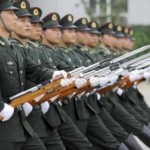Myanmar is aflame, not only because of the turmoil within but also heavy fighting along its borders with China and with India; with fleeing Myanmar refugees streaming into China and India. In the north, the ‘Brotherhood Alliance’, a coalition of three well-armed militant groups, namely Myanmar National Democratic Alliance Army (MNDAA), Ta’ang National Liberation Army (TNLA) and the Arakan Army (AA), has launched a major offensive in Shan State of Myanmar bordering China, Laos and Thailand straddling the ‘Golden Triangle’. The offensive launched on October 27 is codenamed Operation 1027 based on the launch date. Unconfirmed reports say Shan State-based Kachin Independence Army (KIA) has also joined the operation.
The ‘Brotherhood Alliance’ has overrun over 100 Myanmar military outposts/bases and seized control of crucial border towns and checkpoints, Including Chinshwehaw checkpoint on the China-Myanmar border trade route, which is an important source of revenue for Myanmar’s military junta. In one instant, rebels used drones to attack a goods convoy near the town of Mu-Say, destroying over 100 trucks and causing losses of over US $14 million. The offensive is pushing towards Laukkai, the capital of Kokang in the northern part of Shan State.
Yangon recently witnessed anti-China protests (allowed by the government) for supporting armed groups in Myanmar.
.This is a major setback for the Myanmar military. The fighting has forced many refugees into China. China has ties with the Brotherhood Alliance and would probably arm and train some of the refugees; to employ them asymmetrically against Myanmar. This would increase China’s clout in Myanmar. But because of the spate of refugees, China also initiated combat training activities along its border with Myanmar on November 25; using armoured vehicles, artillery firing and troop exercises.
In a show of military muscle, China is holding joint naval drills with Myanmar. Three PLA Navy (PLAN) vessels (destroyer ‘Zibo’, frigate ‘Jing Zhou’ and supply ship ‘Qian Dao Hu’), with about 700 sailors arrived at Yangon on November 29. Officials from both sides had discussed details of the joint maritime security exercises a day earlier. Yangon recently witnessed anti-China protests (allowed by the government) for supporting armed groups in Myanmar.
Why China has decided to add muscle to its diplomacy and asymmetric approaches in Myanmar could have multiple reasons, some of which are as under:
• There is speculation that the National Unity Government (NUG), including the Myanmar National Democratic Alliance Army, is being supported, financed and armed by the US-led West to checkmate Chinese influence in the region.
• China has links with the Brotherhood Alliance but fears the Alliance’s northwards push could be engineered by the West – similar as America pushed Islamic State to the Badakshan region of Afghanistan bordering Tajikistan to counter Russian and Chinese influence.
• As the gateway to China’s Belt and Road infrastructure project, stability of Shan State is vital for Beijing.
• Speeding up the China-Myanmar Economic Corridor (CMEC) and development of the deep-water port at Kyaukpyu(akin to Gwadar in Pakistan).
…there is heavy fighting between the rebels and the Myanmar military in the Chin state across the border from Mizoram.
• China perceives an unstable Myanmar would enable covert PLA entry for guarding CMEC projects in Myanmar (same as the CPEC in Pakistan) and PLAN presence in Kyaukpyu.
• Instability in India’s Manipur State and northeast is seen as an opportunity with main focus on Arunachal Pradesh.
The Myanmar military is fully stretched with fighting also spreading to Myanmar’s borders with Thailand and Laos, as also the Sagaing and Magwe regions with local People’s Defense Forces (PDF) ambushing convoys and reinforcements of the Myanmar military. There are reports of desertions in the Myanmar army and the reserves being readied for frontline battles.
Concurrently, there is heavy fighting between the rebels and the Myanmar military in the Chin state across the border from Mizoram. Anti-Junta rebels have captured two towns close to the only two border crossings between Myanmar and India; Rikhawdar close to Zokhavthar in Mizoram and Kampat in Sagaing around 60 km from Moreh in Manipur. Moreh, incidentally, is part of the India-Myanmar-Thailand Trilateral Highway project.
According to the United Nations, over 26,000 people from Myanmar’s Rakhine State are displaced since November 20, 2023 after fresh fighting broke out between Myanmar’s Military and the Arakan Army (AA). The UN reports around 5000 people from Myanmar have entered Mizoram following fresh air strikes by the Myanmar Army in areas bordering India.
The fall of Rikhawdar resulted in the influx of some 5000 refugees into Mizoram. According to Reuters, 43 Myanmar army soldiers entered Mizoram after their military bases were overrun by the rebels, nearly 40 of whom were sent back through a different border crossing point. The report further says that another batch of 29 Myanmar army soldiers entered India on November 16 after fleeing from an attack by Chin insurgents on their military base.
Only 10 km fencing of the Manipur-Myanmar border is completed and tendering for 80 km has been done of the unfenced 388 km. Also, the India-Myanmar border is not fully settled.
China has been training and arming the Peoples’ Liberation Army (PLA) of Manipur, as also arming Naga insurgents plus Myanmar-based insurgents including the Kanglei Yawol Kanna Lup (KYKL). With the ethnic strife in Manipur, China is now also arming the Zomi Revolutionary Army (ZRA) which had earlier handed over their arms under an agreement with India. Ataullahabu-Ammar Jununi, head of Arakan Rohingya Salvation Army (ARSA) in Myanmar is a Pakistani national in communication with Pakistan’s ISI and LeT, who also receives funds from Saudi Arabia.
The UFO over Manipur’s Imphal airport in November 2023 was obviously a Chinese spy balloon. This indicates that China is monitoring the situation in Manipur very closely. The Myanmar-based terrorist organizations like the KYKL now operating in Manipur (including 12 armed KYKL terrorists captured by an infantry column on June 24 in Manipur forced to be handed back by a Manipur MLA) are more likely to advance Chinese interests. Besides, Chinese agents would enter India with refugees.
Of the 1,643 km-long India-Myanmar border, Manipur shares a border of 398 km with Myanmar. Only 10 km fencing of the Manipur-Myanmar border is completed and tendering for 80 km has been done of the unfenced 388 km. Also, the India-Myanmar border is not fully settled.
A recent report by Oslo’s Peace Research Institute states that 6,337 civilians were killed and 2,614 wounded in the first 20 months following Myanmar’s military coup (February 1, 2021 to September 30, 2021). Ironically, civilian lives don’t matter much these days; 15,000 plus (including over 6,000 children) have been killed and 26,000 plus wounded in Gaza since October 7 this year in Israel’s offensive actions, with the toll rising every day.
The NUG and rebel forces don’t have heavy arms other than weaponry captured from the Myanmar army. But rebels have drones and small arms. The quality and quantity of western support to rebels is not known but the Myanmar military is certainly hard pressed. The dilemma for China is that all armed groups in Myanmar are not under its control and the West is influencing some groups?
Whether military rule in Myanmar will continue with Chinese support (on Chinese terms) or will the Military Junta engage the NUG in talks for a coalition government remains a question mark. Latter is a Catch 22 situation – military wanting to retain supremacy in the new government, NUG not agreeing, and the West wanting enhanced instability to stop Beijing’s access to the Indian Ocean circumventing Malacca Straits.
India’s biggest concern should be that both out eastern and western flanks (Myanmar and Pakistan) have become highly unstable.
India’s relations with Myanmar’s Military Junta have remained lukewarm because of Western sanctions. At the same time, the NUG also is not happy with Delhi for not having supported them as they wanted. Did we keep requisite channels open with both to cater for opportunities and unforeseen contingencies emerging in the future or did we let the situation resolve itself with our focus on global issues? While US led West and China are actively meddling in the internal turmoil in Myanmar, India is merely a helpless onlooker unable to mitigate the consequential fallout on India.
India’s biggest concern should be that both out eastern and western flanks (Myanmar and Pakistan) have become highly unstable. China is sitting pretty with Pakistan in its lap China intends to do the same in Myanmar. China has also drawn/is drawing Maldives, Sri Lanka, Nepal and Bhutan into its strategic sphere and change of government in Bangladesh next January would complete India’s encirclement.
Finally, the most ironical part is that the US-led West is more than happy with the above setting – an encircled India that would lean more and more towards the US.





